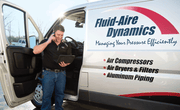A cooling system is an essential component of an industrial air compressor. Compressors use either air-cooled or water-cooled systems, and selecting the right one can improve performance, extend equipment life, and even reduce energy costs — potentially lowering gas and heating bills.
Why Do You Need a Cooling System for Your Air Compressor?
Air compressors generate significant heat, making cooling a crucial factor in system design. In an oil-injected rotary screw air compressor, circulating oil removes most of this heat, but discharge air can still exceed 160°F. Discharge air from oil-free and two-stage reciprocating compressors may reach 300-350°F.
This excess heat creates several challenges:
- Air dryers struggle when inlet temperatures exceed 100°F, leading to moisture buildup and condensation in the system.
- Downstream equipment may suffer from degraded seals, lubricant loss, and premature component failure.
- The compressor room can overheat, affecting the compressor itself and straining HVAC systems in indoor installations.
- Excess heat causes oils and lubricants to break down faster, leading to early failure, increased maintenance, and potential system damage.
Proper cooling helps maintain efficiency, prevent failures, and reduce energy costs.

What Is an Air Compressor Aftercooler?
Rotary screw air compressors and piston compressors require a cooling system to remove excess heat from compression. An aftercooler, a type of heat exchanger, absorbs heat from compressed air and helps remove moisture — eliminating about 70% before it reaches the dryer. Without an effective aftercooler, dryers must be oversized to handle excess moisture.
Most rotary screw compressors include an integrated aftercooler, whether air- or liquid-cooled. An efficient aftercooler ensures system performance, protects equipment, and improves safety. Key benefits include:
- Moisture removal: Reduces strain on air dryers by eliminating ~70% of excess moisture.
- Temperature control: Prevents air from exceeding dryer temperature limits.
- Equipment protection: Shields downstream tools from heat and moisture damage.
-
Safety: Lowers fire risk by cooling discharge air before it contacts hoses.
Air-Cooled Compressor vs. Water-Cooled Compressor: What’s the Difference?
Both air-cooled and water-cooled (or liquid-cooled) aftercoolers act as heat exchangers, removing excess heat from compressed air. The key difference lies in the cooling medium: air-cooled compressors use ambient air, while water-cooled compressors rely on circulating liquid (usually water or a glycol/water mix).
Air-Cooled Compressor

Air-cooled rotary screw air compressors use ambient air to lower compressed air temperature, making them the most common cooling method for rotary screw and rotary vane compressors. Compressed air moves through coils inside the aftercooler while a fan blows cool air over the surface, dissipating heat. Cooling fins increase surface area for heat transfer.
- Temperature reduction: Air-cooled aftercoolers lower air temperature to 15-20°F above ambient temperature. If the surrounding temperature is 85°F, the compressor outlet air will be around 100°F.
- Moisture removal: As the air cools, some water vapor condenses and must be drained.
- Self-cooling options: Some piston compressors use a belt guard aftercooler, leveraging the compressor’s belt-driven airflow to save space.
Aire Tip: The optimal operating temperature range for rotary screw air compressors is between 50-85°F.
Read more: Optimal Temperature Range for Compressed Air Equipment.
Water-Cooled Compressor

A water-cooled compressor uses circulating liquid (i.e., a fluid heat exchanger) to absorb heat from compressed air. Heat is transferred as compressed air moves through coils, with water circulating around them to remove excess heat. These systems are more energy-efficient and better suited for high-volume, high-pressure applications.
- Greater cooling efficiency: Water-cooled rotary screw air compressors can reduce air temperature to 10-15°F above water temperature, offering superior heat dissipation with lower energy use. This makes water-cooled compressors a better choice if ambient temperatures are routinely above 90-100°F.
-
Higher installation costs: While more expensive to install and maintain, liquid cooling is more effective for demanding applications.
There are two main types of water-cooled aftercoolers: closed-loop systems and open or evaporative systems:
- Closed-Loop Systems (Recycling Water): Water circulates continuously, passing through a fluid heat exchanger (e.g., a shell-and-tube exchanger) or refrigeration unit to cool before re-entering the system. These systems use less water but require regular inspection and maintenance. In colder climates, glycol is added to prevent freezing, though this slightly reduces heat transfer efficiency.
-
Open (Evaporative) Systems (Continuous Water Supply): Water is sprayed over cooling coils, draining off or evaporating to remove heat. Some facilities reclaim heated water for industrial processes, reducing waste. This method provides the most efficient cooling for high-pressure applications (above 250 PSI) and high-volume production environments but consumes significant water, making cost a concern.
Air-Cooled vs. Water-Cooled Air Compressors: Pros and Cons
Both types of cooling systems have their place in the industry, and each has unique pros, cons and typical uses. This table summarizes the differences between air-cooled and water-cooled compressors.
| Air-Cooled Compressors | Water-Cooled Compressors | |
|---|---|---|
| Pros | - Less expensive - Lower maintenance - Simple operation - Used to Heat Facility |
- Higher cooling efficiency - Quiet operation- Lower space requirements - Better cooling ability in high ambient temperatures |
| Cons | - Requires more space - Hard to keep compressor room coolDoes not work well in high ambient temperatures |
- More systems maintenance - Higher operating costs - Open systems require large volumes of high-quality water |
| Typical Use | - General industrial compressed air applications below 200HP - Most rotary screw compressors |
- High ambient temperature applications (>90°F) - Larger HP applications with large volumes of air to cool (e.g., centrifugal compressors) |
Requirements for Air Compressor Cooling Systems
Proper installation is critical to prevent air compressor overheating and ensure efficient operation. Each cooling system — air-cooled vs. water-cooled — has specific requirements that must be met.
Installation Requirements for Air-Cooled Air Compressors
Air-cooled compressors need ample space and ventilation for effective heat dissipation. Key considerations:
- Ventilation: Install near an outside wall or roof vent to direct heated air outdoors. Exhaust fans or ductwork may be required.
- Ambient temperature: Performance can be affected by extreme temperatures; additional cooling or heating may be needed.
-
Space: Requires adequate clearance for proper airflow around the unit.
Installation Requirements for Water-Cooled Air Compressors
- Water-cooled compressors require a steady water supply, treatment, and disposal solutions. These systems use heat exchangers and cooling loops connected to an external water source, such as a cooling tower or chiller.
- Water supply: Must provide consistent flow and pressure. Open systems may use natural water sources (ponds, rivers, lakes, wells) instead of municipal water.
- Water quality: High-quality cooling water is essential. Filtration or chemical treatment may be needed to prevent scale, corrosion, or biological buildup — especially if using untreated environmental water.
-
Water disposal: Some regions restrict cooling water discharge. A closed-loop cooling system may be required.
Costs of Air-Cooled vs. Water-Cooled Air Compressors
Choosing between air-cooled and water-cooled compressors involves evaluating initial costs, energy expenses, infrastructure needs, and cost recovery potential. The right choice can lead to significant energy savings and even reduce gas and heating bills through heat recovery.
Initial Cost
- An air-cooled compressor has a lower upfront cost due to its simpler design with fewer components.
- A water-cooled compressor requires additional equipment, such as heat exchangers, pumps, and cooling towers, increasing initial costs.
Power Demand & Energy Costs
- An air-cooled compressor may consume more power in hot environments, as it must work harder to dissipate heat.
- A water-cooled compressor often uses less energy due to water’s superior heat transfer properties. However, energy costs for pumps, chillers or cooling towers must be factored in.
Infrastructure Requirements
- Air-cooled units require adequate airflow and proper ventilation, which may require fans or ductwork to ensure enough cooling air is available and hot air is carried away.
- Water-cooled systems need a steady supply of high-quality cooling water and disposal solutions. A closed-loop cooling circuit reduces water costs but still requires heat exchangers and pumps.
Cost Recovery Through Heat Capture & Water Reuse
- Air-cooled systems provide limited heat recovery, though some facilities can redirect waste heat for space heating.
-
Water-cooled systems offer greater heat recovery potential. Heated water can be repurposed for industrial processes, space heating, or a hot water heating system, reducing gas and heating costs. Additionally, greywater reuse for irrigation or non-potable applications cuts water expenses.
Cost Comparison: Air-Cooled vs. Water-Cooled Compressors
| Factor | Air-Cooled Compressor | Water-Cooled Compressor |
|---|---|---|
| Initial Cost | Lower (fewer components) | Higher (requires pumps, heat exchangers, etc.) |
| Energy Use | Higher in hot environments | Lower, but depends on cooling system energy use |
| Infrastructure Needs | Requires ventilation, fans, or ductwork | Needs water supply, treatment and disposal system |
| Maintenance Costs | Lower, easier upkeep | Higher due to water treatment & scaling risks |
| Heat Recovery Potential | Limited (heat dissipates into air) | High (heat can be reused for process heating, reducing gas bills) |
| Water Consumption | None | Higher for open systems, lower for closed-loop |
| Long-Term Savings | Moderate (less infrastructure cost) | High if heat recovery & greywater reuse are implemented |
Things to Consider When Choosing a Cooling System for Your Screw Air Compressor
Selecting between air-cooled vs. water-cooled screw compressors depends on cost, space, maintenance, airflow and application needs.
Cost
- Upfront Cost: An air-cooled screw compressor is typically cheaper to install; water-cooled units require additional infrastructure like pumps and heat exchangers.
-
Operating Cost: Water-cooled systems consume less energy but may increase water costs. Heat recovery can offset expenses, reducing energy bills.
Maintenance Requirements
- Air-cooled systems need frequent cleaning due to dust buildup, but have simpler maintenance (fans/blowers).
-
Water-cooled systems require more upkeep (water treatment, pump servicing, heat exchanger cleaning) but operate efficiently in demanding applications.
Space and Ventilation Requirements
- Air-cooled systems need ample ventilation and airflow, often requiring ductwork or exhaust fans.
- Water-cooled systems have a smaller footprint but must be near a water source and have proper disposal infrastructure.
CFM & Industry Suitability
- Air-cooled rotary screw compressors are ideal for moderate CFM applications where heat is manageable with ambient air.
- Water-cooled rotary screw compressors handle very high CFM, high-pressure applications efficiently and maintain stable air.
Best Fit by Industry
- Air-cooled: An air-cooled screw compressor is best for construction, automotive, and general manufacturing, where simplicity, durability and low cost matter.
- Water-cooled: Ideal for process industries already using water cooling (e.g., food, pharma, electronics), especially in high-CFM or high-pressure environments.
Environmental Considerations
- Air-Cooled: Best for moderate climates with good ventilation and airflow, where excess heat can be easily dissipated.
- Water-Cooled: May be required for high ambient temperature (>90-100°F) environments where air cooling is insufficient.
Should You Buy an Air-Cooled or Water-Cooled Air Compressor?
Which type of cooling system is best for your air compressor? The choice between an air-cooled vs. water-cooled screw compressor depends in part on the air compressor size, your environment, and if you have an existing cooling system.
- Air-cooled compressors are less expensive and lower maintenance, making them ideal for most applications (95% of rotary screw compressors). They handle up to 350°F discharge temperatures and 250 PSI.
- Water-cooled compressors are better for high-temperature or high-pressure applications, dusty environments, and high-CFM applications. They handle discharge temperatures up to 450°F and pressures up to 435 PSI.
Aire tip: A separate trim aftercooler can be used in an air-cooled system if additional cooling is needed during the hot summer months.
Sizing Your Air Compressor Cooling System
Aftercoolers must be sized appropriately to get the anticipated amount of cooling. Sizing for an air compressor aftercooler depends on four variables:
- The CFM of the air compressor
- The operating pressure (PSI) of the compressed air system
- The discharge temperature of air from the compressor
- Ambient temperatures
The higher the CFM, pressure, and temperatures, the larger the aftercooler will need to be. Not sure of your CFM requirements? Check out our CFM calculator.
Aire tip: When sizing an air-cooled aftercooler, always size it for the highest ambient temperatures expected in your environment at 100% humidity.

Caring for Your Air Compressor Aftercooler
Your aftercooler requires regular maintenance for proper operation. That includes:
- Regularly drain condensate from the system. A zero-loss drain valve will drain excess liquid automatically while conserving compressed air.
- For air-cooled systems, inspect and clean the fan system on a regular basis. Keep the coils and cooling fins free of dust and debris, which will reduce cooling efficiency.
- For liquid cooling systems, monitor water quality on a regular basis and inspect and clean the system.
Frequently Asked Questions
What are the requirements for air compressor cooling systems?
How do costs compare between air-cooled and water-cooled compressors?
How do I size my air compressor cooling system?
How should I care for my air compressor aftercooler?
Need Help Choosing the Right Air Compressor Cooling System?
If you’re in the market for a new air compressor, make sure you choose the right type of cooler. Fluid-Aire Dynamics can help you evaluate your compressor cooling options and choose the best cooling system for your needs. We can also help you size, install and maintain your system.
Talk to an Aire expert today.





